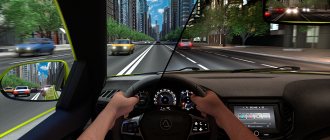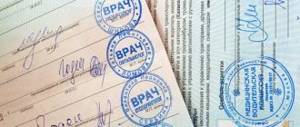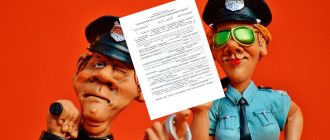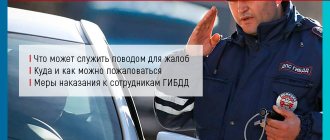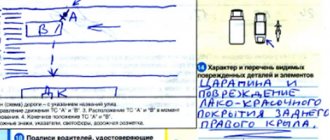There shouldn't be any mistakes
When passing the theory test at MREO, they were previously allowed to make 2 mistakes. Now this rule remains, but has undergone changes. For each mistake made, the examinee must answer 5 additional questions. For 2 errors - by 10. If you answer at least one of the additional questions incorrectly, the theory can be considered failed.
You need to complete the main test in 20 minutes. Each question that remains unanswered after the end of the allotted time is considered incorrect. But you will have to answer 5 additional questions in just 5 minutes.
Practical part of the exam
Passing the exam on the site has also become more complicated - if previously it was enough to successfully complete three exercises out of five, now obtaining a license is possible only after completing all five exercises without errors. These include:
stop for boarding and disembarking passengers;
performing maneuvers in confined spaces.
There are also new exercises that can be included in the exam:
performing reverse maneuvers;
stopping at different speed levels;
The examiner may, at his discretion, combine two exercises into one and this will count as one maneuver.
Points for violations in the city
When taking the exam in the city, a certain point is assigned for each violation. For example:
unfastened seat belt - 3 points;
engine stalled at the start - 1 point.
To successfully fail the exam, it is enough to score 5 points. Previously, the city test was treated less strictly; some violations were simply forgiven. Now the future driver needs to pull himself together, calm down and start moving confidently. It is important to remember that you should not agree to provocative actions by the examiner (for example, if he says to stop under a prohibiting sign). You must act strictly according to traffic rules,
In terms of points, certain violations carry maximum penalties. These include:
driving into oncoming traffic;
ignoring a pedestrian at a crossing;
driving through a prohibiting traffic light or a prohibiting sign;
stopping in the wrong place;
ignoring demands to let vehicles have priority on a given section of the road;
improper overtaking or U-turn.
Slightly fewer points will be awarded for the following violations:
driving around the city at low speed without a valid reason;
sudden braking without creating a dangerous situation;
turn without turning on the turn signal.
But examiners can forgive an incorrect assessment of the situation on the road and sudden movements behind the wheel.
Retake your license in 2021
Those who fail the exam on the first attempt are eligible for a second attempt. If you fail the theory test, you will be accepted next time in a week. After the second failure - again in a week, after the third - in a month.
By analogy, they retake practice exams - the first three attempts are a week apart, the subsequent ones - a month later. In total, a driving school graduate has 8 attempts.
You should not expect privileges and leniency when passing driving exams. In 2021, it will be difficult to successfully complete all tasks - you need to prepare for this in advance. Remember that studying the traffic rules and knowing the traffic situation in the city will help you pass the exam successfully.
We have already talked about how the internal exam is held at a driving school. In this article we’ll talk about how to pass the first stage of the traffic police exam, namely the theoretical part. What is tested on this exam? What mistakes are made most often? What do you need to know to pass the first time? We will answer all these questions right now.
Other innovations in 2018
- You can take the exams at any department of the State Traffic Safety Inspectorate of the Russian Federation for persons with Russian citizenship.
- Changing to an automatic transmission does not allow further driving with a manual transmission.
- Training in a driving school is a mandatory requirement for passing certification in the traffic police.
- The application can be submitted electronically through the government services website.
- With the written consent of their parents or guardians, students under 18 years of age can take exams along with others.
As can be seen from the information provided above, every year the procedure for obtaining rights becomes more and more complex and stringent. Only those motorists who have conscientiously prepared to pass all stages of the exam and are 100% confident in their knowledge and its practical application can obtain a driver’s license.
What will happen in the theory exam at the traffic police
There are 20 theory questions in one ticket. The exam is considered passed if the examinee answers at least 18 correctly. The ticket includes questions of different categories:
- general provisions;
- road signs;
- road markings;
- traffic lights and traffic controller signals;
- starting to move, maneuvering;
- movement speed;
- overtaking, advancing, oncoming traffic;
- stopping and parking;
- driving through intersections;
- use of external lighting devices and sound signals;
- malfunctions and conditions for admitting the vehicle to operation;
- traffic safety and driving techniques;
- provision of pre-hospital medical care;
- general responsibilities of drivers;
- location of the vehicle on the roadway;
- priority of route vehicles;
- towing mechanical vehicles;
- use of special signals;
- driving on highways;
- training riding and additional requirements for the movement of cyclists;
- traffic in residential areas;
- movement across railway tracks;
- pedestrian crossings and stopping places for route vehicles;
- transportation of people and goods;
- driver responsibility;
- use of hazard warning lights and warning triangles.
How is the driving school exam conducted?
First, an internal exam is held on the territory of the driving school. It is identical to the test in the traffic police, but is for informational purposes only. Consists of 2 parts – theory and practice.
The first stage - theory
This testing is carried out on a computer. A special program is used that simplifies the examination. One ticket consists of 20 questions. The future driver's task is to give correct answers to at least 18 of them. That is, he is given the right to make 1 or 2 mistakes.
If there were more than 2 errors, the exam automatically stops. The student is not allowed to take part in the practical part of testing.
3 mistakes when preparing for the theoretical part
Most students in driving schools believe that theory is not the main thing. They think that attending only practical classes will give them the opportunity to become full-fledged drivers. But that's not true.
Another mistake is studying only those questions that will be on the exam. Such people do not think about the meaning of the question. Their task is to learn the answer and take a long time to solve traffic tickets in order to learn everything. But because There are about 1800 questions, it will be almost impossible to keep all the answers in memory.
The third mistake is not regularly attending a driving school. This does not provide an opportunity to gain complete knowledge. A person will only know certain points, which is why he risks getting into an embarrassing situation in the future.
This is interesting: What is car restyling and why is it done? 4 reasons for holding it
The second stage - exercises on the training ground (site)
Only those who have successfully passed the theoretical part are allowed to take part. After which they need to drive through the internal area of the driving school.
5 basic maneuvers that a student must successfully perform:
- Stop the car on the rise, and then move forward. A rollback is considered an error.
- "Snake". Initially, a movement trajectory is created using colored cones. The task is to drive along the line without hitting a single figure. The most common mistake is a stalled engine.
- Turning around in a confined space. This exercise is necessary to test the driver's coordination.
- Parallel parking. The student needs to park the car so that it is parallel to other types of transport on the site. This is a typical situation in parking lots near shopping centers, hospitals, and parking lots.
- Reverse entry. The most important maneuver that every driver should be able to do.
The inspector selects 5 maneuvers, 3 of which the student needs to do perfectly. Retake of 1 error is allowed.
Stage three – driving in the city
Only those who have successfully passed the theory and exercises on the site can take it, because This is the most critical part of the exam. It is important that when taking this part of the test the student is presented with a previously familiar vehicle. This will help you avoid many basic mistakes.
The inspector chooses the route. Usually this is a city center with many traffic lights, intersections, bus stops, road signs, pedestrian crossings and other details.
During the ride, the instructor makes notes with penalty points. There are three categories in total: for minor errors - 1 point, for medium - 3 points, for gross - 5 points. The exam is considered failed if the applicant scores a total of 5 points or more.
Listen carefully to the instructor during the testing process! Often he likes to provoke students to break the rules.
You can retake driving in the city only a week after the first attempt. You need to complete it in 3 months, because... After this period, marks for theory and maneuvers on the site are canceled.
How the theory exam is conducted
Submission of the theory to the traffic police occurs as follows. A group of examinees enter a classroom to take a computer-based test. The exam can also take the form of a test on a special form.
The test has 20 questions. Each of them contains answer options. The examinee must select only one by checking the box on the computer or on the form. It is not necessary to follow the order of questions. You can answer easy questions first, then difficult ones, at your discretion. To eliminate errors in computer testing, the answer is accepted by the PC only when pressed twice.
The time allotted for passing the theoretical exam at the traffic police is 30 minutes.
Most test takers experience anxiety and uncertainty. The main thing to remember is that there are 800 exam questions in total. If you have everything sorted out and have taken online tests multiple times in preparation for passing the theory, everything will work out. At the traffic police exam there will be nothing new on the tickets, just as there will be no oral questions or other unscheduled moments. All theory tickets are the same throughout Russia.
A little theory
Before choosing a driving school, you should carefully read the current legislation. Read about the current rules for passing the driving test and the number of possible attempts. But the most important thing is to find out what the risks of buying a driver’s license are. Because Many Russians do not want to undergo training, finding an easier way to obtain an important document.
Legislation: latest changes
From 2021, the rules for conducting the traffic police exam and the procedure for obtaining a driver’s license have been updated. The rules are fixed in the Decree of the Government of the Russian Federation No. 1097 of October 24, 2014 (as amended on March 23, 2017 No. 326) “On admission to driving vehicles” and in the document “Rules for conducting examinations for the right to drive vehicles and issuing driver’s licenses.”
The main provisions of this resolution:
- now driver’s licenses are issued not only at the traffic police departments, but also at the MFC (clause 2);
- those who have not reached 18 years of age need the consent of not all legal representatives, but only one of them (clause 18);
- notification of refusal to issue rights is now sent not directly to the applicant, but to multifunctional centers, where the reasons for making such a decision are indicated (clause 22);
- if the driver wants to exchange his license for a new one before it expires, then, according to section 3, paragraph 26, he can do this without passing the exam.
And the main last change, which is relevant as of March 2018, is the need to present a medical report to renew a driver’s license. But this does not apply to those who applied for a new document in the event of the theft of the previous one, upon expiration of the validity period and if they wish to redo the rights before the end of their validity period. This driver's license is valid for 10 years.
According to the amendments to paragraph 38 in section 4, foreigners are now allowed to exchange their driver’s license for a Russian model. The main condition is passing testing on the territory of the Russian Federation for those categories of vehicles that are lower in the classification. Foreigners also need a medical certificate.
Categories and subcategories of vehicles
Until 2013, there were 5 categories of vehicles in the Russian Federation. But since 2014 (which is current as of March 2021), their number has increased. There were restrictions on the weight of vehicles and the power of the power plant.
Explanation of all categories and subcategories of vehicles:
- Category A. Gives you the right to ride a motorcycle with a side trailer. Transport can consist of 2, 3 or 4 wheels. The total weight cannot exceed 400 kg.
- Category A1. Applies to scooters whose engine capacity cannot exceed 125 cc.
- Category B. Thanks to this driver’s license, you can drive a passenger car whose weight is limited to 3.5 tons. You can carry more than 8 passengers in the cabin at the same time.
- Category B1. Necessary for driving an ATV or tricycle.
- Category BE. Allows you to drive passenger cars with a trailer whose weight cannot exceed 750 kg.
- Category C. Grants the right to drive trucks weighing up to 3.5 tons.
- Category CE. A trailer can be attached to a truck if its weight does not exceed 3500 kg.
- Category C1. A trailer can be attached to a truck if its weight is less than 750 kg. This right does not apply to drivers with category D.
- Category C1E. Makes it possible to drive trucks with trailers weighing up to 12 tons.
- Category D. Buses fall into this category. The driver has the right to carry more than 8 passengers. It is allowed to attach a trailer to the bus.
- Category DE. A trailer can be attached, but its weight cannot exceed 3.5 tons.
- Category D1. Gives the right to transport up to 16 people. A trailer can also be attached to the vehicle.
- Category D1E. You are allowed to drive a bus with a trailer whose weight may exceed 750 kg. The total weight of the vehicle cannot exceed 12 tons.
- Category M. Allows you to control an ATV and a moped. Available to drivers over 16 years of age.
- Categories Tm and Tb. Only needed by trolleybus and tram drivers.
This is interesting: Car sharing - what is it and how does it work? 6 advantages of car sharing over regular car rental
In paragraph 38, information on categories and subcategories of driver’s licenses has been added. Now category “D” is higher than categories “A”, “B”, “C” and their subcategories.
What you need to pass the exam successfully
To significantly increase your chances of successfully passing the theoretical exam in the traffic police, you need to pay attention to the following points:
- Learn the theory of traffic rules by heart. We remember our school years and begin to delve into the features. Some questions may seem very difficult. To learn in such cases, we recommend that you analyze the question, study it thoroughly and try not just to memorize it, but to understand the essence. Then it will be easy for you to navigate during the exam.
- Ability to use computer technology will be an advantage. We are no longer in the “paper” age - the era of computers has come a long time ago. The traffic police exam can be taken on a computer.
- Behave with restraint and calm. If you feel that you are unable to concentrate due to anxiety, take a mild sedative that does not have a sleeping effect. You don't want to scare everyone in the class with your snoring, do you?
- Pay special attention to difficult theoretical issues. There are questions that are remembered the first time, but some, on the contrary, are not remembered for the life of us. These are the ones we work with. We are trying to identify a pattern and, as already said, memorize it.
- Take online tests at home. Textbooks are a good thing, but practice at home using online trainers, of which there are now many on the Internet.
Nikita Orlov, auto expert:
«The theoretical exam in the traffic police is certainly not as important as practical driving skills. At the same time, without passing the theory, you simply will not be allowed to practice. Many people try to “memorize” traffic rules or exam papers, but this is pointless. You need to not only know the traffic rules, but also understand them. Do not try to guess the answer on the exam card, much less remember the point of the rules regulating the situation. The most effective training method will be the assistance of an existing driver. Ask parents or friends who already have a driver's license to go over with you those tickets that are particularly problematic. Only by understanding the principle of applying traffic rules in practice will you catch luck by the tail in the theoretical exam.”
Documents for passing the exam in the traffic police
In order to take driving tests and obtain a driver’s license, a citizen must provide the following documents to the traffic police department:
- Applicant's passport;
- Application for passing the exam (can be submitted in written or electronic form);
- Conclusion of the medical commission (driver’s medical certificate);
- Document confirming completion of training at a driving school;
- A valid driver's license is available (for example, to obtain an additional category);
- If the applicant is between 16 and 18 years old - written parental consent.
At the same time, since the exams have not yet been passed and there are no grounds for issuing a driver’s license yet, a receipt for payment of the state fee is not required. After receiving these documents, a date for the exam at the traffic police, as well as a place and time, is set.
Common mistakes
In most situations, when a cadet cannot pass the theory the first time, the reason is ignorance of the questions, inattention and haste:
- Inattention. Pay special attention to the words “prohibited” and “allowed.” For some reason, these words are most often confused, although they have opposite meanings.
- Rush. Once you sit down at the computer, strictly follow the instructions of the traffic police officer. You should not rush and press buttons, because the program can complete the test without starting it.
- Ignorance. Most cadets make mistakes on questions related to intersections, traffic controllers and trams. Study these questions thoroughly and take your time when answering them.
To avoid mistakes, use didactic materials and practice more often. Only when you feel that you are answering questions not just automatically, but with an understanding of what is required of you in the question, will you feel confident and will not make mistakes. Don't be afraid that you won't have enough time. 30 minutes is enough to read and answer 20 questions on the ticket. To make sure of this, time yourself when you study at home.
Stages of passing exams in the traffic police according to the new rules
Actually, the exams for obtaining a license in the traffic police for a future driver consist of three parts (stages), these are:
- Theoretical exam;
- Testing practical driving skills on the race track;
- Testing driving skills in urban conditions.
Theoretical exam on knowledge of traffic rules
When passing the theoretical part of the traffic police exam (first stage), your knowledge is assessed:
- Traffic rules;
- Legislative standards relating to road safety;
- Fundamentals of safety when driving a vehicle;
- Basic information on the approval of a vehicle for operation;
- Rules for first aid in case of road accidents;
- Rules of driver liability in the field of civil, administrative and criminal law.
The exam is held in a standard form with exam questions formed into separate exam tickets, 20 questions in one ticket. The acceptable response time for a received ticket is 20 minutes. The exam is taken electronically, and by selecting an answer to a question once, you are allowed to correct it once. When you select an answer a second time, it is frozen and is considered finally selected without the possibility of correction.
In order for the exam to be considered passed, you must correctly answer 20 questions on the ticket, or all additional questions if errors were made on the ticket. You can find all tickets for which the “theory” is accepted on the official website of the State Traffic Safety Inspectorate (GIBDD.rf).
Only after successfully passing the theoretical exam, the examinee is allowed to take the practical exam.
Second part of the exam: driving on a race track
At the testing ground of the state traffic inspectorate, the examinee confirms his possession of practical driving skills in an equipped racetrack or closed area. To successfully pass this part of the exam, you must complete the exercises already practiced during your training at a driving school.
The exercise starts from the starting line, stopping is allowed without crossing the “STOP” line. For each mistake, the inspector assigns penalty points. If the number of errors is less than that which ensures failure of the exam, you are considered to have successfully passed the test and are allowed to take the third part of the exam - practical driving in urban traffic conditions.
Passing a practical driving test in the city
As an examination exercise, you will be asked to drive a certain distance along a road route in a city. Routes for testing driving skills are usually located in the center of the city. The traffic situation when driving in the center quite clearly reveals both the level of knowledge of traffic rules and practical skills in navigating a traffic situation.
When passing a route in the city, you will be asked to park, move, overtake a bus, etc. There is also such a method of testing driving confidence as a provocation on the part of the inspector, proposing to perform an action against the rules of the driving license - if the examinee feels confident and knows what he is doing, he will not succumb to such a provocation and, accordingly, will not earn a penalty point for a mistake.
Successfully passing all three parts of the exam will mean that the exam has been passed, and you will receive a driver's license of the exact category for which you studied and passed the exam. A driver's license is issued for 10 years, after which it is changed according to the general procedure.
Retake
If a cadet can be allowed to retake the autodrome and city tests in a period of two days to a week, depending on the workload of the traffic police inspectorate, then the theory is allowed to be retaken the very next day. The number of retakes is not limited. True, you will have to pay 100 rubles for a retake, each subsequent one is another 100 rubles more expensive. For example, to retake the theory for the fourth time, you will have to pay 400 rubles.
If you follow the rules and strictly follow the recommendations of the traffic police officers, you can pass the theoretical exam the first time without much difficulty. The main thing is not to rush, read the questions carefully and, of course, prepare diligently for the exam.
How the exam is conducted
The traffic police exam includes three stages:
- theory;
- performing elements on the race track (site);
- route around the city.
All these stages are completed in one day. If the examinee fails any part of the examination, a subsequent retake of the successful examination is not required.
But it is important to remember that a positive mark for the exam stage is valid for three months. If this deadline is missed, the entire exam will need to be taken again.
How to pass the traffic police exam the first time: general tips
- The most important assistants for those taking the exam are self-confidence, composure and calmness.
- Before the exam, it is very important to relax and get into the right frame of mind.
- Do not overuse sedatives. Very often, sedatives cause drowsiness and apathy. And this is unlikely to benefit the examinee.
- It is important to feel comfortable during the exam, so a neat appearance and comfortable clothing will be helpful.
- It is better to turn off your mobile phone during the exam so that an unexpected call does not throw you off balance and knock you out of the right mood.
How to pass the theory in the traffic police the first time: tricks that will help everyone
The theoretical part of the exam is a test consisting of multiple-choice questions. A certain number of examinees are allowed into the examination room, depending on the number of computers in it.
At the very beginning of the exam, the inspector explains to those present the rules for taking the exam. The countdown to the end of the test begins from the moment the tests are launched on the computer. One error is allowed in tests.
Success in passing the theoretical part includes:
- Good knowledge of traffic rules: in order to prepare for testing, you need to spend a lot of time memorizing the rules. The most effective way to solve traffic tickets or read a summary written in an accessible form.
- Information in this form is perceived much more effectively than memorizing the text of an official document. When the decision on tickets becomes automatic, passing the test to the traffic police will not be difficult.
- Composure and attentiveness: before you start taking the test, you need to carefully and thoughtfully read all the questions, concentrating on every word and expression. Sometimes examinees make mistakes simply because they were in a hurry, did not read the task carefully, or accidentally pressed the wrong key.
- Consistency: When completing a task, it is best to answer questions that are not in doubt first. This way, in the end there will be much more time left for tasks for which you are not 100% sure of the answer.
- Behavioral culture: an exam is an important event, so you need to behave accordingly. Do not distract others with questions or discuss the task loudly. If something is not clear, you need to raise your hand and quietly call the examiner. He will come over and give clarification. Challenging behavior is unacceptable.
After leaving the examination class, there is no need to heatedly discuss the test task and other issues with those awaiting the exam, or call family and friends, joyfully and emotionally sharing the news. It is important to remain calm and self-controlled.
By fulfilling all these simple requirements, passing the theoretical exam at the traffic police is very easy.
Stories from experienced people
Inna, marketer, 32 years old:
I didn’t pass the theory test at the traffic police the first time. I was very worried and made a mistake in the first test by not reading the question carefully. This made me very upset and everything went wrong from there. But I drew conclusions, and the second time everything was fine!
Evgeniy, economist, 26 years old:
I really wanted to get my license. I often wondered: How to pass the theory in the traffic police the first time: are there any tricks, or is it just luck? For some period of time this became the goal of my whole life. And when you really want something, it will definitely come true. The theory worked for me the first time. I was confident in my knowledge, so I felt calm during the exam. Not a single question caused any difficulties. So, you need to learn everything in advance.
Autodrom: relaxed and easy
When the theoretical part of the exam is over, it's time to get behind the wheel. For now only at the racetrack (or site).
This stage involves passing 3 elements to be chosen by the examiners:
- slide (overpass);
- garage (entrance to the box);
- parallel parking;
- snake;
- turns;
- turning around in a narrow space;
- intersection (this element is only available on automated racing tracks, not on regular ones).
To pass the race track perfectly the first time, you need to train a lot, honing all the elements until they become automatic.
During training, you need to listen to the instructor’s advice and remember all the “tricks” that he demonstrates.
The most important thing in the exam:
- listen carefully to the examiner and pay attention to his instructions;
- listen to the car so as not to stall at the most inopportune moment;
- monitor the marking line and the position of the limit posts when performing various elements, so as not to inadvertently go beyond the limits and demolish the fence;
- move smoothly and slowly. On the autodrome there is no need to be reckless and drive headlong. The permissible speed is 10 km per hour.

